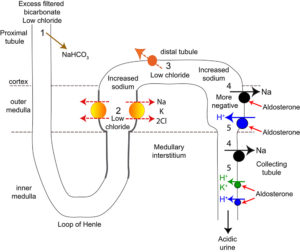In a chloride-depleted metabolic alkalosis, e.g. gastric vomiting, the hypochloremia and kidney is responsible for maintaining and worsening the alkalosis as follows:
1: Excess filtered bicarbonate is retained with sodium in the proximal convoluted tubule instead of chloride as the latter is depleted. The kidney is sodium avid due to hypovolemia, which is caused by the disease resulting in chloride loss.
2. Less sodium is absorbed by the Na-K-2Cl carrier in the loop of Henle (due to the hypochloremia), resulting in increased sodium delivery to the distal tubule.
3. In the early distal tubule, the NaCl cotransporter cannot reabsorb the extra sodium efficiently as chloride is low, resulting in increased sodium delivery to the collecting tubules. This also results in aldosterone release
4. The increased sodium delivered to the cortical collecting tubule increases flow rate and stimulates sodium resorption by the sodium transporter (ENaC) in principal cells. Sodium absorption increases the negative charge in the lumen, stimulating the H-ATPase (sodium-dependent in the cortical region only) and H/K-ATPase pumps of type A intercalated cells and causing H and K excretion. Aldosterone facilitates the action of both the ENac and H- and H/K-ATPases. The ENac is also directly stimulated by bicarbonate concentration in the tubular lumen (increased due to increase in blood with subsequent filtration and incomplete resorption in the proximal tubule) and interstitial fluid (from the blood alkalemia).
5. The ENaC also absorbs sodium in the medullary connecting tubule, in exchange for hydrogen or potassium excreted by the H-ATPase or H/K-ATPase (also found in the cortical collecting tubule, although it is not depicted there in this image). Both of the latter are also stimulated by aldosterone.
As a result, the urine is acidic and the blood becomes more alkaline as hydrogen excretion in the distal nephron is linked to bicarbonate absorption. Potassium deficiency will contribute to the alkalosis, by decreasing sodium absorption in the loop of Henle (Na-K-2Cl pump) and by the H/K-ATPase excreting hydrogen and not potassium.

